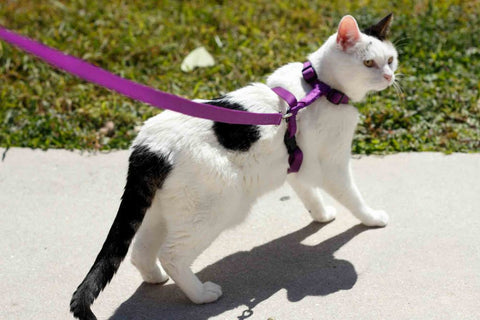First Things First.
So, you’ve looked at the pros and cons of having an indoor cat, versus an outdoors adventure cat & you have decided that you’d like your new kitten to be able to have access to the great outdoors. However, there are some conditions that must be met before your pet ventures outside for their first ever taste of the great outdoors:
- Your pet must be at least 5 months old
- Ensure they are up to date with all their immunisations
- Ensure they have had their worm & flea tablets
- Make sure they have been neutered
- Get them micro-chipped
I know from unfortunate personal experience how vital it is to have your pet micro-chipped. I live in town & when one of my cats was hit by a car the driver took him to the nearest vet, who was then able to call me through contact details contained on the micro-chip.
Using a quick-release collar with an id tag is also a good idea – that is if your cat will allow it! Also, if you have an older cat who’s come to stay then they’ll require a few weeks to acclimatise to their new home before you let them out.
Check your garden is free of any potentially harmful items, such slug pellets, and if you have a pond cover it with netting. Some people suggest that putting soiled litter around the perimeter of your garden will help them establish their territory, although I personally haven’t found this necessary for my cats.

I bought a harness & leash for my Bengal for his first few weeks of exploration in the garden. However, he is now a year old and quite happily goes in and out of the cat flap whenever he wants. I was worried at first that he’d go onto the busy road in front of my home, but he’s very happy wandering around the garden and does love being indoors with me! The main thing that I have learnt is to not panic, because most cats come back after a few minutes; leave the door open, and have a tasty snack ready for them on their return. Cats aren’t stupid, they know which side their bread is buttered and will always return for food! Furthermore, cats are cautious by nature, so let them explore at their own pace and give them space.
The steps that I recommend are:
- Step one. Each morning, before giving them their breakfast, open the back door to allow the cat to wander outside if they choose. Don’t pick them up as this will stress them out.
- Step two. When your cat does go out, let them explore for 30 minutes.
- Step three. After 30 minutes call them back & then give them their breakfast. Again, don’t pick them up.
- Step four. Repeat this each day and gradually increase the time. Before you realise it they’ll be happy to go out on their own.

How To Train Your Cat To Use A Cat Flap.
Now that your adventure cat is happily coming and going you may want to fit a cat flap if you’re not home all day. As is most often the case where your pet is concerned, use lots of praise, patience and a few treats as a reward when training your cat to use the flap. Open and close the flap: when it closes and makes a noise give your pet a treat so that it associates the sound when closing with something positive. You can always encourage your cat to use the flap by taping it open.
However, the noise made by the cat flap swinging open and closed may be off putting to cats of a more nervous disposition, in which case following these simple steps may help:
- Start by holding the flap open
- Encourage your kitten by holding their favourite toy, or a treat, in the opening
- Reward your kitten when they approach the opening of the cat flap; they will soon start to associate the cat flap with a positive experience.
- When your cat becomes comfortable approaching the cat flap, begin coaxing them through it by encouraging them with a treat if they poke their head or paw through it. Reward and praise them for each small step.
- When your cat goes through the cat flap for the first time give them an extra special treat and lots more praise!
When your fearless feline has got used to going through an open cat flap, the next stage is to teach them how to push through a closed one. Each cat is different and some will understand how to do this intuitively whilst others need guidance using toys or treats.
I mentioned previously, I used a harness & leash for the first few times with my Bengal, but be aware that not all cats will accept one! I would just increase the time each day & go at my cats speed. At first he was too nervous to venture beyond the back patio and would run inside at the first squawk of a bird. Patience, lots of praise & a few treats offered here and there is the key here. It isn’t long before they get used to this exciting new world & it now gives me a lot of pleasure to see my cat chasing after flies and bugs in the garden. It’s good for them physically & for their mental stimulation.
Good luck!

